 Those busy bee boffins at Samsung have announced the Samsung p207, billed as “the world’s first EDGE phone with VoiceMode provided by VoiceSignal.”
Those busy bee boffins at Samsung have announced the Samsung p207, billed as “the world’s first EDGE phone with VoiceMode provided by VoiceSignal.”
Promising to liberate users from the tyranny of texting on tiddly keypads, the smarty pants p207 uses “revolutionary” Speech-To-Text (STT) input technology.
Like its PC desktop counterparts, the user first has to ‘train’ the p207 through a series of spoken prompts that captures voice tone and intonation.
Once the user has adapted the system to their own dulcet tones, they can start dictating away – and the more that the learning VoiceMode is used, the more it adapts to the user’s voice.
Cleverly, voice texters can also address their message by dictating the recipient by name or number.
Peter Skarzynski, senior vice president of wireless terminals at Samsung wasn’t one to underplay the product’s capabilities: “Samsung is dedicated to integrating first-to-market technologies into its wireless phones to empower users in their everyday lives.”
“It is a great accomplishment for Samsung and a monumental day in the industry, as the p207’s advanced voice technologies transform day-to-day communication.”
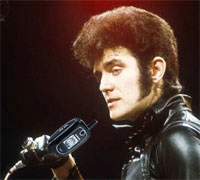 The phone – looking a bit Alvin Stardust-esque in its tight, all-black covering – also comes with EDGE high-speed network, an integrated VGA camera/camcorder, MP3 ringtones, wireless multimedia messaging and instant messaging.
The phone – looking a bit Alvin Stardust-esque in its tight, all-black covering – also comes with EDGE high-speed network, an integrated VGA camera/camcorder, MP3 ringtones, wireless multimedia messaging and instant messaging.
If this voice-to-text technology actually works (and we have a few doubts), it could prove a real boon, especially to people with fingers the size of large Bavarian sausages.
But the name’s a bit silly though. Who’d want to call a phone ‘page 207’?
 In what isn’t a surprise move Steve Jobs has announced the Apple “Mac Mini”, a low cost addition to the Macintosh computer range. Priced at $499 (~€380, ~£265) and $599 (~€457, ~£319), it can sit in the palm on your hand (measuring 6.5 inches (16.51 cm) square and just 2 inches (5.08 cm) tall and weights just 2.9 pounds (1.32 kg). True to form for Apple, it looks great.
In what isn’t a surprise move Steve Jobs has announced the Apple “Mac Mini”, a low cost addition to the Macintosh computer range. Priced at $499 (~€380, ~£265) and $599 (~€457, ~£319), it can sit in the palm on your hand (measuring 6.5 inches (16.51 cm) square and just 2 inches (5.08 cm) tall and weights just 2.9 pounds (1.32 kg). True to form for Apple, it looks great. 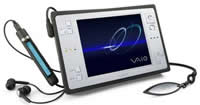 The latest addition to Sony’s VAIO range of personal computers is really, really different. The VAIO VGN-U750P (around US$2,000) is a palmtop computer that also goes under the more firendly name of the Vaio U and weighs considerably less than the average laptop (167x108x26mm, 550g), yet boasts a fully fledged Intel-based environment running Windows XP Professional SP2 as opposed to the specialised platforms powering other handhelds, such as Palm OS, Windows Mobile or even Windows XP Tablet PC Edition.
The latest addition to Sony’s VAIO range of personal computers is really, really different. The VAIO VGN-U750P (around US$2,000) is a palmtop computer that also goes under the more firendly name of the Vaio U and weighs considerably less than the average laptop (167x108x26mm, 550g), yet boasts a fully fledged Intel-based environment running Windows XP Professional SP2 as opposed to the specialised platforms powering other handhelds, such as Palm OS, Windows Mobile or even Windows XP Tablet PC Edition. Designed for law enforcement, perimeter security and long-range video links,
Designed for law enforcement, perimeter security and long-range video links,  Sega are launching a wide reaching, active and colourful campaign to trumpet in the arrival of Sega SuperStars, the first non-Sony game developed for the EyeToy. Available from October 22nd, the campaign will highlight the excitement and interactive nature of the game.
Sega are launching a wide reaching, active and colourful campaign to trumpet in the arrival of Sega SuperStars, the first non-Sony game developed for the EyeToy. Available from October 22nd, the campaign will highlight the excitement and interactive nature of the game. 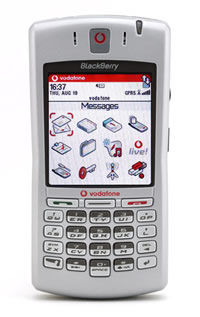 Vodafone have today announced a new form of BlackBerry, the 7100v. It has been designed with the BlackBerries creator, RIM (Research In Motion) and will be the first release of a new form factor.
Vodafone have today announced a new form of BlackBerry, the 7100v. It has been designed with the BlackBerries creator, RIM (Research In Motion) and will be the first release of a new form factor.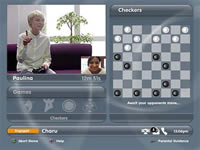 Slowly and steadily, Sony is building on the usage and application of the ground-breaking EyeToy webcam add-on for their Playstation 2. The latest announcement is EyeToy:Chat, which expands the tool into a far more social area.
Slowly and steadily, Sony is building on the usage and application of the ground-breaking EyeToy webcam add-on for their Playstation 2. The latest announcement is EyeToy:Chat, which expands the tool into a far more social area.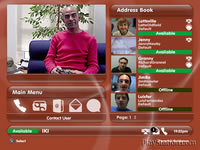 Clearly safety will be a big concern for parents and Sony’s London Studios, the original inventors of EyeToy, who developed Chat and have spent considerable efforts in trying to make the product as safe as possible. User will need to register with Playstation Net to use it and will only be bale to take part once they enter the PIN that is send to their home address. With Chat rooms being moderated and a clear processes for grievances Sony feels “‘EyeToy: Chat’ is one of the safest communication packages available on any system on the market.”
Clearly safety will be a big concern for parents and Sony’s London Studios, the original inventors of EyeToy, who developed Chat and have spent considerable efforts in trying to make the product as safe as possible. User will need to register with Playstation Net to use it and will only be bale to take part once they enter the PIN that is send to their home address. With Chat rooms being moderated and a clear processes for grievances Sony feels “‘EyeToy: Chat’ is one of the safest communication packages available on any system on the market.”